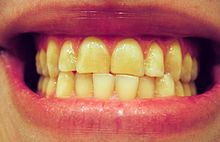| Bruxism | |
|---|---|
| Other names | Teeth grinding,[1] dental compression syndrome |
 | |
| Tooth wear caused by tooth-to-tooth contact can be a sign of bruxism. | |
| Specialty | Dentistry |
| Symptoms | Minimal, sensitive teeth, tooth wear, soar jaw muscles, headaches[2][3] |
| Complications | Damage to the teeth[4] |
| Types | Awake, sleep[3] |
| Causes | Unknown, neurological problems, side effects of medications[2][1] |
| Risk factors | Smoking, alcohol, sleep apnea, stress[3][1] |
| Diagnostic method | Based on symptom[3] |
| Differential diagnosis | TMJ disorders, malocclusion[4] |
| Treatment | Relaxation therapy, mouthguards, physical therapy, biofeedback[2] |
| Frequency | 8% to 31%[3] |
Bruxism is unconscious and excessive grinding or clenching of the teeth.[2][3] It may occur well awake or when sleeping, with the later often being more severe.[2][5] Symptoms may be minimal or include sensitive teeth, tooth wear, soar jaw muscles, and headaches.[2][3] Complications may include damage to the teeth.[4]
The cause is frequently unknown.[2] In some cases it may be related to neurological problems or the side effects of medications such as SSRIs.[2][1] Risk factors include, smoking, alcohol, sleep apnea, and possibly stress.[3][1] Diagnosis is generally based on symptom.[3] Often it is reported by family members.[4]
Treatment is recommended when symptoms occur.[3] This may include relaxation therapy, mouthguards, physical therapy, sleep hygiene, and biofeedback.[2][1] Evidence for specific measures; however, is weak.[6]
Bruxism is a common behavior; affecting 8% to 31% of the population.[3] Onset is often between the age of 10 to 20.[4] It affects the young more often than older people.[3] Awake bruxism is more common than sleep bruxism.[3] People may frequently be mislead by alternative medicines.[4]
References edit
- ^ a b c d e f "Teeth grinding (bruxism)". nhs.uk. 23 October 2017. Retrieved 10 January 2021.
- ^ a b c d e f g h i Lal, SJ; Weber, KK (January 2020). "Bruxism Management". PMID 29494073.
{{cite journal}}: Cite journal requires|journal=(help) - ^ a b c d e f g h i j k l m Beddis, H; Pemberton, M; Davies, S (28 September 2018). "Sleep bruxism: an overview for clinicians". British dental journal. 225 (6): 497–501. doi:10.1038/sj.bdj.2018.757. PMID 30237554.
- ^ a b c d e f Ferri, Fred F. (2017). Ferri's Clinical Advisor 2017 E-Book: 5 Books in 1. Elsevier Health Sciences. p. 212. ISBN 978-0-323-44838-3.
- ^ "Bruxism - Dental Disorders". Merck Manuals Professional Edition. Retrieved 10 January 2021.
- ^ Lobbezoo F, van der Zaag J, van Selms MK, Hamburger HL, Naeije M (July 2008). "Principles for the management of bruxism". Journal of Oral Rehabilitation. 35 (7): 509–23. doi:10.1111/j.1365-2842.2008.01853.x. PMID 18557917.